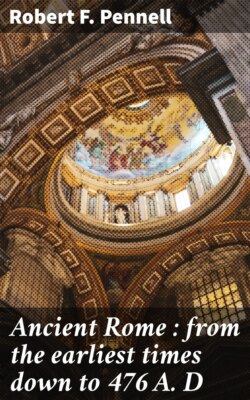Читать книгу Ancient Rome : from the earliest times down to 476 A. D - Robert F. Pennell - Страница 7
На сайте Литреса книга снята с продажи.
CHAPTER II. THE EARLY INHABITANTS OF ITALY.
ОглавлениеTable of Contents
So far as we know, the early inhabitants of Italy were divided into three races, the IAPYGIAN, ETRUSCAN, and ITALIAN. The IAPYGIANS were the first to settle in Italy. They probably came from the north, and were pushed south by later immigrations, until they were crowded into the southeastern corner of the peninsula (Calabria). Here they were mostly absorbed by the Greeks, who settled in the eighth and seventh centuries all along the southern and southwestern coast, and who were more highly civilized. Besides the Iapygians, and distinct from the Etruscans and Italians, were the Venetians and the Ligurians, the former of whom settled in Venetia, the latter in Liguria.
The ETRUSCANS at the time when Roman history begins were a powerful and warlike race, superior to the Italians in civilization and the arts of life. They probably came from the north, and at first settled in the plain of the Po; but being afterwards dislodged by the invading Gauls, they moved farther south, into Etruria. Here they formed a confederation of twelve cities between the Arno and the Tiber. Of these cities the most noted were Volsinii, the head of the confederacy, Veii, Volaterrae, Caere, and Clusium. This people also formed scattering settlements in other parts of Italy, but gained no firm foothold. At one time, in the sixth century, they were in power at Rome. Corsica, too, was at this time under their control. Their commerce was considerable. Many well preserved monuments of their art have been discovered, but no one has yet been able to decipher any of the inscriptions upon them. The power of these people was gradually lessened by the Romans, and after the fall of Veii, in 396, became practically extinct.
The ITALIANS were of the same origin as the Hellénes, and belonged to the Aryan race, a people that lived in earliest times possibly in Scandinavia. While the Hellénes were settling in Greece, the Italians entered Italy.
At this time the Italians had made considerable progress in civilization. They understood, in a measure, the art of agriculture; the building of houses; the use of wagons and of boats; of fire in preparing food, and of salt in seasoning it. They could make various weapons and ornaments out of copper and silver; husband and wife were recognized, and the people were divided into clans (tribes).
That portion of the Italians known as the LATINS settled in a plain which is bounded on the east and south by mountains, on the west by the Tyrrhenian Sea, and on the north by the high lands of Etruria.
This plain, called LATIUM (flat country), contains about 700 square miles (one half the size of Rhode Island), with a coast of only fifty miles, and no good harbors. It is watered by two rivers, the Tiber, and its tributary, the Anio. Hills rise here and there; as Soracte in the northeast, the promontory of Circeium in the southwest, Janiculum near Rome, and the Alban range farther south. The low lands (modern Campagna) were malarious and unhealthy. Hence the first settlements were made on the hills, which also could be easily fortified.
The first town established was ALBA; around this sprung up other towns, as Lanuvium, Aricia, Tusculum, Tibur, Praeneste, Laurentum, Roma, and Lavinium.
These towns, thirty in number, formed a confederacy, called the LATIN CONFEDERACY, and chose Alba to be its head. An annual festival was celebrated with great solemnity by the magistrates on the Alban Mount, called the Latin festival. Here all the people assembled and offered sacrifice to their common god, Jupiter (Latiaris).
(Illustration: Latium)
